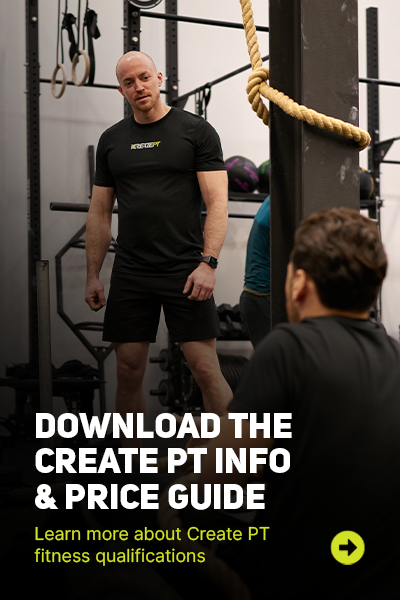What is the earning potential of a personal trainer?
Recreational fitness is a relatively new phenomenon, it’s only in the last 40-50 years that people started exercising for general health or enjoyment. Prior to that it was only really for sport and probably military or public services like police that trained to get stronger or fitter.
In the 80’s people started to want to get fitter, stronger, leaner and healthier which lead to an explosion of gyms and all the related fitness services. This has carved out entire new industries and created thousands of jobs worldwide for people passionate about health, fitness, helping others, and earning a decent income in the process.
Obviously the one we’re here to talk about is personal training, so what is the earning potential for a personal trainer? The average yearly income for a personal trainer in the UK according to Google is £29,200.
In this article we’re going to go through the costs you’ll face as a PT, the different ways you can earn an income, ways you can boost your income, and how much you’ll be left with at the end of all this. Personal training can be a very lucrative business, also giving you the freedom and flexibility to work on your own terms, so let’s dive into how much you can earn as a personal trainer.
The Costs
Get qualified
First things first, you need to get qualified, this is where we come in. You need a Level 3 Personal Trainer Course to get fully qualified and legally train clients 1-2-1 in either an employed or self-employed capacity.
Personal training courses range massively in price from a few hundred to several thousands depending on what you want from the course. You can check out our blog about choosing the right personal training course here.
With Create PT you can spread the cost of your course over up to 24 months interest free, so you could be paying as little as £35 per month to get fully qualified. Once you start charging for PT, you could recoup the monthly cost of your course with one PT session per month.
Get insured
Whether you’re working in an employed or self-employed role it is important to get insured. Insurance will only cost around £100 a year, if a client were to seriously injure themselves while you’re training them you could be liable for thousands in damages, so the insurance really is a no-brainer.
Gym rent
This will only apply if you plan to work self-employed within a gym, however if you aren’t paying rent, you’ll be paying the gym in some capacity. If you’re employed, you’ll likely get a guaranteed salary then a percentage of your PT income, so the rent is replaced by the cut you pay to the gym. If you do hours in lieu of rent, then your time is replacing the rent.
It is important to understand that the gym you work in offers a constant flow of new members that are potential clients for you, and they provide a gym space with equipment for you to use, all of which comes at a cost. So although it may feel unfair paying a cut of your earnings to the gym, it is a worthwhile investment.
Gym rents vary hugely around the country, in London you could pay £1500 per month in rent in some gyms, but the average outside London is around £400-500 per month. This may also vary depending on how many clients you train, with some gyms offering a sliding scale to help support you while you build a business.
As a personal trainer, this is likely to be your biggest expense, so make sure whatever set up you’re going to be on, that you factor this cost into your calculations for your earning potential.
Equipment
If you plan to sidestep the gym setup altogether and train clients from home, travel to them or a public space then there are other costs you need to factor in.
You’ll need to invest in a range of equipment. You’re unlikely to be able to kit your home gym out as well as a commercial gym so you’ll have to think wisely about what to buy. Most personal trainers get a range of dumbbells, kettlebells, som functional kit like skipping ropes, medicine balls and suspension trainers. Then if you have the space and budget maybe a squat rack, bench and barbell with some plates.
This doesn’t sound like a lot but it adds up quickly, so make sure to take it into account when working out your earning potential.
Potentially the biggest cost to not working at a gym though is the fact you won’t have a member base to market your services to. You’ll have to rely on word-of-mouth, digital and local marketing, which can be very challenging. However in return for this you get to keep 100% of your income so the reward may well be worth the effort!
Employment Options
Gym Employment
As discussed above there are a number of options available to you as a personal trainer. The first we’ll look at is an employed role at a gym. The employed part is likely to include duties such as inductions, classes, cleaning, marketing outreach (in some cases), consultations, workshops and anything that may benefit the members of the club.
In return for this you’ll be paid a wage. The wages paid by gyms don’t tend to be particularly generous but they give you a guaranteed income to provide some security, and the duties you’ll be carrying out are mostly perfect ways for you to try to sell your paid personal training services.
You’ll have some routine due to the fixed hours, and the members of the club are all available to you as potential clients. The biggest downside in general is the percentage that the club takes from your PT sessions. This varies massively from club to club, but big chains such as Virgin Active may pay newly qualified PT’s as little as £15 per session from a £45 charge to the member. This usually increases as you pick up more clients, and some chains and independent gyms are much more generous with how much they pay their trainers, so make sure to do your research.
On average you could expect to earn just over minimum wage for the hours you work for the gym. However it is important to remember that this is likely only going to be 10-20 hours per week and the remainder of your time will be spent offering personal training services and similar for a much higher hourly rate.
Self-Employed / Freelance
Working within a gym on a self-employed basis can be a great way to maximise your earning potential as a personal trainer. As discussed above, you’ll have a fixed monthly rental payment to make, but in exchange you get to keep 100% of your PT income, you have a captive audience of members and you are your own boss.
Being your own boss may not appeal to some people but it means you have the flexibility to work when you want (or at least when your clients want) and charge what you want. There may still be some restrictions in place regarding pricing to avoid PTs within the club competing too aggressively on price, but you’ll still have a lot of control.
By knowing in advance what your monthly rental payment will be you can also budget very effectively. You know you’re always going to have to take that fixed cost into account, but if you generate more PT income, that rental cost remains fixed, which is a great way to boost your earning potential.
On average you can charge £30-40 per hour for personal training, although this is much higher in London, with some trainers charging over £100 per hour.
How many hours of PT you do per week is a careful juggling act, you want to avoid burnout but maximise how much you earn, plus the clients won’t just fall on your lap, you’ll have to build a business over time. But once you’ve done some planning you should be able to establish what is sustainable and profitable for you. You can use our income calculator here to figure out how much you could earn.
20 sessions per week at £35 per session is £700 per week which is around £36k per year. This is a very achievable and realistic target, and below we go through some ways you can boost your income even further.
Online Coaching
There are several ways to offer online coaching, we won’t go into detail on them all in this article but to summarise:
- Bespoke programming – This involves writing tailored training programmes and possibly nutrition plans for your clients on a 1-2-1 basis. You would usually include a weekly/bi-weekly or monthly call to monitor their progress and everything about this service is completely individualised for that client.
- As such, it is fairly labour intensive and the client is getting a great service, so you can charge quite a lot. This would normally start from around £100 per month and can be up to £500+.
- Generic programming – You write one programme and sign multiple clients up onto the same programme. There is no individualisation of the programme but depending on the service you offer you may want to include a group Whatsapp or Facebook group, or a 1-2-1 call periodically. With this, the programming workload remains the same regardless of how many people are following the programme, but depending on what extras you offer, the workload may increase with additional clients.
- As such pricing for this style of programming varies massively from as little as £5/month for a mass marketed generic programme with no feedback, up to around £100/month for a semi-generic programme that includes feedback and the option to adapt the programme.
- This method is the most scalable because if you offer either no feedback or a group community to provide feedback en masse then the sky is the limit for how many clients you can take on.
- Online classes/PT – Delivered via your preferred video calling platform, you would host either group classes or 1-2-1 sessions which are effectively an online version of an in-person session. These were particularly popular during lockdown but have dwindled since then as people prefer the in-person experience. You could charge a reasonable amount, and technically speaking could host an unlimited number of people in an online group class, but this may be a tough sell, unless you have a big personal audience or brand.
Additional Income Streams
Group Classes
Most gyms offer classes in some format, whether it’s some gym-floor HIIT classes, spinning, Yoga, aerobics, you’re likely to find something that you enjoy and are good at. Classes can pay from £15 – £50 an hour depending on what you’re teaching and location, so it can be a great way to supplement your income.
Selling Fitness Plans
Similar to the generic programming online model above, you can package your programming up into blocks such as a 12 week summer shred programme for example. You can then sell them within the gym or online via your social media or website.
Nutrition Guidance
As fitness professionals we know that you can’t out-train a bad diet, but your potential clients may need some help with this. You could boost your earning potential by providing nutrition templates with recipe guides to go with them. Offer with this a consultation and food diary analysis to help your clients understand how they can improve their nutrition and implement some positive habits.
Workshops
Gyms love to offer additional services to their members to help with retention, and what better way than to have one of their knowledgable trainers offering a workshop on a topic they’re passionate about? This could be on improving your squat, mobility, plant-based dieting, training through the menopause, any number of topics. If the gym see enough value in it they may offer to pay you, alternatively you can charge a fee to attendees.
Pricing Strategies
Value-Based Pricing
In any walk of life it can be difficult to sell yourself, and if you lack confidence it can be even more challenging to put a decent price tag on your services. As a personal trainer you need to try to shift from the going rate for how you price your services to basing it on the perceived value.
If you’ve done a thorough consultation with a client you should fully understand their goals. If you were to ask them how much they would pay to achieve those goals, the answer would almost always be more than you’re charging them. For example, how much would an overweight client pay to lose 15kg? How much would your office working father of 3 pay to get a 6 pack?
If you can shift your proposition to focus on the value you are delivering to your clients, rather than the transactional nature of them paying you for your time, then you should be able to charge more and more over time as your reputation improves and word of mouth spreads.
Package Deals
Everyone understands the concept of buying in bulk makes it cheaper, well on the receiving end of that you’re also locking that client in for 8, 10, 12, 20 sessions. By giving a bit away, you get all the cash upfront, and you secure that client for the foreseeable future.
For example, you usually charge £40 per hours for PT. Most PTs do this, you offer 10 sessions for £350, making it work out at £35 per hour if they pay upfront. It’s a win/win, the client gets it a bit cheaper and you have the security of them sticking around for a while and the cash in your pocket.
Direct Debit
This feels like a big jump for a lot of personal trainers, going from the conventional pay per session model to a fixed monthly fee. However if done right it can be very liberating. At the end of the day, you’re a professional, you’ve spent a load of money and time getting qualified and honing your trade, you deserve financial security as much as anyone else.
You don’t have to move all of your clients from pay-per-session to direct debit, but for the consistent ones that train regularly you can make it a win/win. Let’s say they usually do 2 sessions a week and they pay you for blocks of 10 sessions at a time, so every 5 weeks you’re chasing them for £350 (or maybe they’re very organised and send it to you without asking).
Currently they just do those 10 sessions and outside of them you have little to no communication, you don’t help with their nutrition or habits outside of the gym. You could offer them a package for £400 per month that includes 10 sessions per month to be used at any time during the month, plus nutrition guidance and regular accountability around their lifestyle.
I would find that a pretty attractive offer, as the client they have the flexibility to do extra sessions some weeks and less other weeks, and now they’re going to get a load of help with the extra stuff that will really make a difference to their health & fitness goals.
For you as the coach, you’re getting the guaranteed monthly income without chasing them, even when they or you go on holiday you’re getting the same money coming in (you fit the other sessions in before/after your holidays). Plus all you’re doing extra is helping them to build healthy lifestyle and eating habits and communicating with them more, which will only make them more likely to stick around for the long run.
As we said, this is not for all clients, but if done right it can really help to build a consistent income and increase your earning potential over time by combining additional services within the package.
Special Offers and Discounts
We’re in two minds about this one, it can devalue your service if you offer discounts, however if done right it can be a welcome boost to a seasonal slow period or some extra cash in your pocket before a holiday without damaging your reputation.
Make sure you don’t run offers all the time, and try to tie the offers into the value-based pricing we discussed above. Eg. “Save £5 per session” is not particularly compelling, but “£100 off our 6 pack by summer programme” may be more appealing to the right audience. Additionally you can run promotions that boost your sales in other ways, such as a referral bonus. Eg. get 2 free sessions when you refer a friend.
Conclusion
Personal training is an exciting career choice that can give you the flexibility to live the life you want to live, while helping people improve themselves and earning you a great living in the process. To achieve this you’ll need to work hard and put certain systems and processes in place to provide you with some financial security and boost your earning potential.
By following our guidelines above you’ll be well on your way to building a successful career as a personal trainer, if you need any further guidance we offer tons in our PT courses and our tutors are always available to help.







